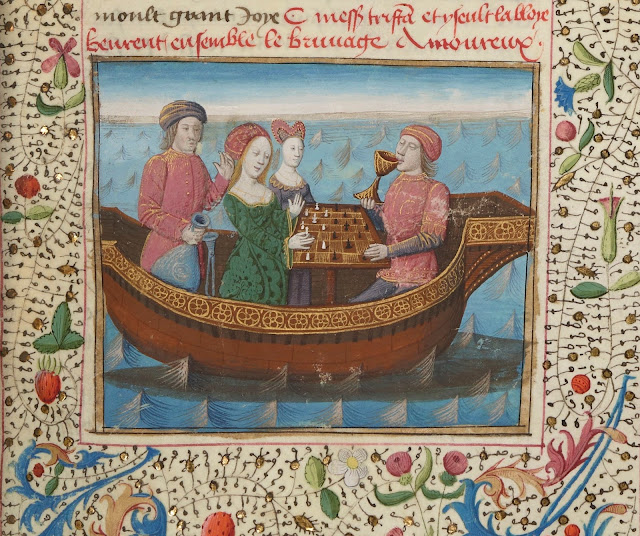 |
| Bibliothèque nationale de France, Public domain, via Wikimedia Commons |
Courtly Love: The Strange Medieval Influence Upon Contemporary Romance
By Eric Silverman
In today’s world, most people want a loving, romantic, long-term exclusive relationship, and eventually marriage and family. But, here’s the strange thing: the model for love, sex, and romance most of us inherit/intuit comes from combining a mix of disparate sources that actually don’t fit very together very well. Today we’ll focus on one of the fascinating sources that subtly shapes our romantic sensibilities to show why it is in tension with some of our other relational goals.
Courtly love was a relational phenomenon amongst the
upper classes in Europe from roughly the eleventh to fourteenth century. It was
a model for relationships that gave women more choice and power in
relationships than many previous models. It is one of the original models for
relationships where interpersonal romantic-sexual relationships could occur solely
grounded in considerations of personal attraction and preference, rather than
practical considerations. Where marriage was often shaped by considerations of
economics, class, and politics. Courtly love was possible between a much
broader range of individuals. The fullest systematic description from the day
can be found in The Art of Courtly Love
by Andreas Capellanus.
This romantic relationship was typically:
Adulterous-
While marriage was shaped by boring, unromantic considerations, courtly love
was a possibility amongst those who had enough wealth for an amount of leisure
and perhaps enough responsibilities or status to require substantial time away
from their spouse. Personal attraction to another’s beauty, character, or charm
could be the basis for such relationships. And these were driven with a strict
focus upon the romantic and passionate.
.jpg) |
| Paul Hudson from United Kingdom, CC BY 2.0 <https://creativecommons.org/licenses/by/2.0>, via Wikimedia Commons |
Transcended Class: While courtly love was not entirely free of class considerations—in practice one had to have higher status than a peasant to have the time, resources, and social opportunities for courtly love—It did allow for more a lot more class flexibility than marriage. From the middle class upwards, the ornate speeches of courtly love were designed to set aside class as one was idealistically drawn to the deep character and beauty of the beloved, which knows no class.
Medium
Term:
While Courtly Love was ‘committed’ in the sense that you weren’t supposed to
have more than one courtly romance at a time, it wasn’t expected to be
lifelong. In fact, much is written about tactics to keep romance alive since it
naturally seemed to diminish after a couple of years. Just as euphoric romantic
attraction tends to diminish over time in most romantic-sexual-marital
structures. However, much of this advice sounds like bad high school dating
advice: make your lover jealous, limit time together, keep the relationship
secret, pretend you are angry and act aloof, etc.
More
Romantic than Sexual: Much of the focus of courtly love is on
romance rather than sex. The stories of courtly love idealize and exaggerate
the significance and hope of even a mere kiss of a small personal token to
represent the beloved’s care for us. It is impossible to know how many of the
courtly romances actually involved sexual intercourse. But, there was good
practical reason to avoid sex within courtly romance… after all, the queen’s
child needs to look a lot like the king rather than her favorite knight.
Let us return to the upshot of courtly love for our
current sensibilities. It is wonderful that our culture enables us to make our
relational decisions based on attraction and free choice rather than economic or
social demands. Yet, there is something incompatible when we try to combine a
passionate medium term model for relationships with the ideal of life
long-exclusive marriage. Most people find it impossible to maintain the
euphoric level of attraction associated with passionate courtly love long term.
So, when people marry for passionate romance, but find that the intensity of
passion dies down after a few years they are often disappointed. And
contemporary neuroscience suggests there are biological reasons why it is
difficult to maintain that level of attraction long-term. So, perhaps, we
should be wary of overvaluing something as fleeting as the intensity of
romance. We should enjoy it while we have it, but a life long relationship can
be about companionship and commitment even if the intensity of romance waxes
and wanes.
Some Relevant Links:
Some Scientific Claims About Passionate Attraction
https://www.today.com/health/how-long-does-passion-last-four-stages-love-t108471
A Movie Clip of Lancelot and Guinevere’s Courtly Love
https://www.youtube.com/watch?v=y21WTmf0V4I
A song from Into
The Woods satirizing the melodrama of medieval courtly love
https://www.youtube.com/watch?v=tvsDObIQFhg
Link to The Art of Courtly Love
https://books.google.com/books/about/The_Art_of_Courtly_Love.html?id=3FLusNnbiF8C
